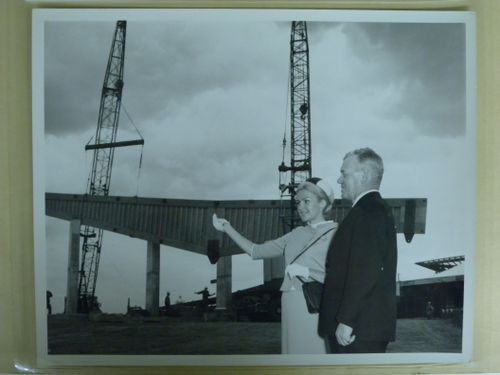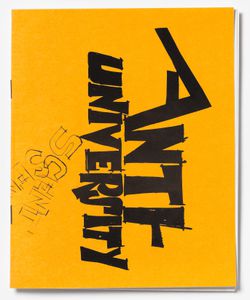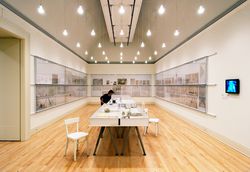ARCH255761
Description:
"Rear Admiral Hugh F. Pullen (Ret'd), general manager of the Atlantic Pavilion, watchesas the first of six 140-foot wooden beams is swung into place to start construction at the pavilion."--Description # 2 retrieved from ARCH260258.
1965-1966
Portrait of Rear Admiral Hugh F. Pullen and of an unidentified woman with the Atlantic Provinces' Pavilion under construction as background, Expo 67, Montréal, Québec
Actions:
ARCH255761
Description:
"Rear Admiral Hugh F. Pullen (Ret'd), general manager of the Atlantic Pavilion, watchesas the first of six 140-foot wooden beams is swung into place to start construction at the pavilion."--Description # 2 retrieved from ARCH260258.
Series
Wenzel Hablik
AP162.S3
Description:
Series documents the contribution of architect Wenzel Hablik to the correspondence circle of Die gläserne Kette. Hablik participated using the pseudonym W.H.. Born in Brüx, Germany, (now Most, in Czech Republic) in 1881, Hablik worked as a porcelina painter from 1895 to 1897 and later as architectural draftsman. Between 1897 to 1902 he studied architecture at the Faschsdule für Tonindustrie und verwandte Gewerbe in Teplitz-Schönau, and at the Kungstgewerbeschule in Vienna in 1902. Between 1905 and 1906, he studied painting at the Akademie für bildenbe Künste in Prague. He worked in Itzehoe, Germany, after an invitation by a patron, Richard Biel, in 1907, where he start collaborating on textile designs with Elisabeth Lindemann, who he married in 1917. His work was exhibited at the Austellung für unbekannte Architeckten in 1919. The same year he joined the Arbeitsrat für Kunst lead by Bruno Taut. In 1925, Hablik published "Zyklus Architektur" an artist folio presenting some of his etched architectural fantasies. He worked for the family workshop by designing textiles and wall hangings. He died in 1934 in Itzehoe. (Source: Ian Boyd Whyte, Bruno Taut and the Architecture of Activism. Cambridge: Cambridge University Press, 1982) The series comprises letters and a drawing by Wenzel Hablik.
circa 1919-1920
Wenzel Hablik
Actions:
AP162.S3
Description:
Series documents the contribution of architect Wenzel Hablik to the correspondence circle of Die gläserne Kette. Hablik participated using the pseudonym W.H.. Born in Brüx, Germany, (now Most, in Czech Republic) in 1881, Hablik worked as a porcelina painter from 1895 to 1897 and later as architectural draftsman. Between 1897 to 1902 he studied architecture at the Faschsdule für Tonindustrie und verwandte Gewerbe in Teplitz-Schönau, and at the Kungstgewerbeschule in Vienna in 1902. Between 1905 and 1906, he studied painting at the Akademie für bildenbe Künste in Prague. He worked in Itzehoe, Germany, after an invitation by a patron, Richard Biel, in 1907, where he start collaborating on textile designs with Elisabeth Lindemann, who he married in 1917. His work was exhibited at the Austellung für unbekannte Architeckten in 1919. The same year he joined the Arbeitsrat für Kunst lead by Bruno Taut. In 1925, Hablik published "Zyklus Architektur" an artist folio presenting some of his etched architectural fantasies. He worked for the family workshop by designing textiles and wall hangings. He died in 1934 in Itzehoe. (Source: Ian Boyd Whyte, Bruno Taut and the Architecture of Activism. Cambridge: Cambridge University Press, 1982) The series comprises letters and a drawing by Wenzel Hablik.
series
circa 1919-1920
archives
Level of archival description:
Fonds
CP138
Synopsis:
The Gordon Matta-Clark collection documents the personal and professional activities of Gordon Matta-Clark through his correspondence, texts, library, artwork and films, created predominantly between 1969 and 1978. Additionally the collection contains correspondence and photographs collected by Anne Alpert, Matta-Clark's mother, and documentation on his work collected by his widow Jane Crawford following his death.
1914-2008
Gordon Matta-Clark collection
Actions:
CP138
Synopsis:
The Gordon Matta-Clark collection documents the personal and professional activities of Gordon Matta-Clark through his correspondence, texts, library, artwork and films, created predominantly between 1969 and 1978. Additionally the collection contains correspondence and photographs collected by Anne Alpert, Matta-Clark's mother, and documentation on his work collected by his widow Jane Crawford following his death.
archives
Level of archival description:
Collection
1914-2008
archives
Level of archival description:
Collection
AP162
Synopsis:
The Die gläserne Kette CCA Collection documents the chain of correspondence exchanged between German architects Hermann Finsterlin, Paul Goesch, Wenzel Hablik, Hans Hansen, Carl Krayl, Hans and Wassili Luckhardt, Hans Scharoun, and Bruno and Max Taut between 1919 and 1920 on the subject of utopian architecture and society. This CCA collection features original copies and reproductions of the correspondence, as well as a limited number of drawings by the members of the group.
1911-1977
Die gläserne Kette collection
Actions:
AP162
Synopsis:
The Die gläserne Kette CCA Collection documents the chain of correspondence exchanged between German architects Hermann Finsterlin, Paul Goesch, Wenzel Hablik, Hans Hansen, Carl Krayl, Hans and Wassili Luckhardt, Hans Scharoun, and Bruno and Max Taut between 1919 and 1920 on the subject of utopian architecture and society. This CCA collection features original copies and reproductions of the correspondence, as well as a limited number of drawings by the members of the group.
archives
Level of archival description:
Collection AP162
1911-1977
From 1966 to 1968, Shadrach Woods and Cedric Price, two architects and educators in Paris and London, found themselves caught up in a vortex of change in education. Like architecture, the field was searching for new models; thinkers sought to reformulate the basic problems of education, rather than simply seeking new solutions to old questions. In this seminar 2014(...)
Shaughnessy House Keyword(s):
Shadrach Woods, Cedric Price, Visiting Scholar, Federica Doglio
24 July 2014, 6pm
Visiting Scholar Seminar: Federica Doglio
Actions:
Description:
From 1966 to 1968, Shadrach Woods and Cedric Price, two architects and educators in Paris and London, found themselves caught up in a vortex of change in education. Like architecture, the field was searching for new models; thinkers sought to reformulate the basic problems of education, rather than simply seeking new solutions to old questions. In this seminar 2014(...)
Shaughnessy House Keyword(s):
Shadrach Woods, Cedric Price, Visiting Scholar, Federica Doglio
Senior Mellon Fellow Antoine Picon argues that in order to contribute fruitfully to the construction of smart cities, design must start from the changing nature of the urban subject and the urban experience.
1 May 2014
Antoine Picon: Smart Cities: A New Challenge for Design
Actions:
Description:
Senior Mellon Fellow Antoine Picon argues that in order to contribute fruitfully to the construction of smart cities, design must start from the changing nature of the urban subject and the urban experience.
Series
Architectural projects
AP056.S1
Description:
The Architectural Projects series, 1984-2003, records 125 architectural projects from Canada, the United States, Germany and Switzerland. These projects include university buildings and campuses, public spaces, civic buildings, offices, interior and industrial design, residences, museums, theatres and concert halls, a winery, and retail stores. The projects include built work, proposals and competition entries. Projects were identified and separated based on distinct project numbers assigned by the creating office, along with the project dates and titles when further clarification was necessary. The project numbering scheme used by the office was not consistent, but most of the numbers are four digits and begin with last two digits of the project start year. These projects are recorded primarily through drawings, but some photographs, paintings, textual records, periodicals, and models are also included in this series. The majority of drawings for each project are originals and a large part of reprographic copies have annotations. The drawings for each project typically consist of surveys, sketches, plans, sections, elevations, axonometric drawings, details, perspectives, and drawings issued for construction. Some of the drawings are mounted for presentation purposes. A large number of furnishing drawings are also included for interior design projects. Photographs in this series show finished work completed by the firm, the project models, and reproductions of drawings and paintings. The paintings in this series are mostly watercolours used for presentation. The textual records are very sparse in this series and consist of rough notes used to supplement drawings. The periodicals are magazines that highlight the completed projects. The amount of materials for each project vary greatly, with built projects having the most complete records and project proposals having the least.
1984-2003
Architectural projects
Actions:
AP056.S1
Description:
The Architectural Projects series, 1984-2003, records 125 architectural projects from Canada, the United States, Germany and Switzerland. These projects include university buildings and campuses, public spaces, civic buildings, offices, interior and industrial design, residences, museums, theatres and concert halls, a winery, and retail stores. The projects include built work, proposals and competition entries. Projects were identified and separated based on distinct project numbers assigned by the creating office, along with the project dates and titles when further clarification was necessary. The project numbering scheme used by the office was not consistent, but most of the numbers are four digits and begin with last two digits of the project start year. These projects are recorded primarily through drawings, but some photographs, paintings, textual records, periodicals, and models are also included in this series. The majority of drawings for each project are originals and a large part of reprographic copies have annotations. The drawings for each project typically consist of surveys, sketches, plans, sections, elevations, axonometric drawings, details, perspectives, and drawings issued for construction. Some of the drawings are mounted for presentation purposes. A large number of furnishing drawings are also included for interior design projects. Photographs in this series show finished work completed by the firm, the project models, and reproductions of drawings and paintings. The paintings in this series are mostly watercolours used for presentation. The textual records are very sparse in this series and consist of rough notes used to supplement drawings. The periodicals are magazines that highlight the completed projects. The amount of materials for each project vary greatly, with built projects having the most complete records and project proposals having the least.
Series
1984-2003
Project
AP018.S1.1969.PR01
Description:
This project series documents the expansion of the Art Gallery of Ontario (AGO) in Toronto from 1969-1974. The office identified the project as number 69006. This project consisted of the vast expansion of the AGO that began in 1969, which largely came about due to a multi-million dollar donation from English sculpture Henry Moore. Most prominent in this project was the design and construction of the Henry Moore Sculpture Centre, a new gallery to house the extensive artworks of Henry Moore in the AGO’s collection. This included $15 million’s worth of art that Moore donated at the start of the project. The project was made up of two phases. The first included construction of the Henry Moore Sculpture Centre, the Sam and Ayala Zacks Wing, a link to the pre-existing Grange mansion, and updates to the art gallery’s finishes. The second phase proposed additional updates to existing finishes. By the end of this project, the architects had also added a public lounge, dining room and cafeteria, a members’ lounge, lecture areas (including the Henry Moore Lecture Hall), classrooms, and spaces for the gallery’s special services. The work was further divided into 4 physical areas of the art gallery (A, B, C and D) and the drawings for this project reflect this division. Before this work had been completed, a “Stage II” to the expansion had already been approved by the owners (Stage II is also included in this fonds, see AP018.S1.1972.PR08). In the documentation, this project was originally called the Henry Moore Sculpture Centre, Art Gallery of Ontario, Expansion Phases 1 and 2. However, as multiple stages to the expansion developed later on, this project eventually became known as the Stage I Expansion. While the project contract was originally given to John B. Parkin Associates, John C. Parkin continued the project under his new firm, Parkin Architects Planners, after parting ways with partner John B. Parkin in 1971. The project is recorded through drawings, textual records, and mounted photographs dating from 1968-1986. There are numerous original drawings showing the design development of the new galleries. Two presentation boards show photographs of the project model. The textual records consist of correspondence with contractors and clients, inspection and other site reports, specifications, contract data, consultancy records, schedules, change orders, financial documentation, conference reports, area calculations, research materials, detail planning records, and project notebooks. Box AP018.S1.1969.PR01.007 contains an index to the textual records, which was created by the office. This project series also contains one box of textual documentation that spans across multiple project series related to the AGO expansion within this fonds (see AP018.S1.1969.PR01.044). This includes press releases, newspaper articles, project proposals and studies, correspondence with Henry Moore, meeting minutes and reports.
1968-1986
Henry Moore Sculpture Centre, Art Gallery of Ontario, Stage I Expansion, Toronto (1969-1974)
Actions:
AP018.S1.1969.PR01
Description:
This project series documents the expansion of the Art Gallery of Ontario (AGO) in Toronto from 1969-1974. The office identified the project as number 69006. This project consisted of the vast expansion of the AGO that began in 1969, which largely came about due to a multi-million dollar donation from English sculpture Henry Moore. Most prominent in this project was the design and construction of the Henry Moore Sculpture Centre, a new gallery to house the extensive artworks of Henry Moore in the AGO’s collection. This included $15 million’s worth of art that Moore donated at the start of the project. The project was made up of two phases. The first included construction of the Henry Moore Sculpture Centre, the Sam and Ayala Zacks Wing, a link to the pre-existing Grange mansion, and updates to the art gallery’s finishes. The second phase proposed additional updates to existing finishes. By the end of this project, the architects had also added a public lounge, dining room and cafeteria, a members’ lounge, lecture areas (including the Henry Moore Lecture Hall), classrooms, and spaces for the gallery’s special services. The work was further divided into 4 physical areas of the art gallery (A, B, C and D) and the drawings for this project reflect this division. Before this work had been completed, a “Stage II” to the expansion had already been approved by the owners (Stage II is also included in this fonds, see AP018.S1.1972.PR08). In the documentation, this project was originally called the Henry Moore Sculpture Centre, Art Gallery of Ontario, Expansion Phases 1 and 2. However, as multiple stages to the expansion developed later on, this project eventually became known as the Stage I Expansion. While the project contract was originally given to John B. Parkin Associates, John C. Parkin continued the project under his new firm, Parkin Architects Planners, after parting ways with partner John B. Parkin in 1971. The project is recorded through drawings, textual records, and mounted photographs dating from 1968-1986. There are numerous original drawings showing the design development of the new galleries. Two presentation boards show photographs of the project model. The textual records consist of correspondence with contractors and clients, inspection and other site reports, specifications, contract data, consultancy records, schedules, change orders, financial documentation, conference reports, area calculations, research materials, detail planning records, and project notebooks. Box AP018.S1.1969.PR01.007 contains an index to the textual records, which was created by the office. This project series also contains one box of textual documentation that spans across multiple project series related to the AGO expansion within this fonds (see AP018.S1.1969.PR01.044). This includes press releases, newspaper articles, project proposals and studies, correspondence with Henry Moore, meeting minutes and reports.
Project
1968-1986
webpages
Making Mamak is a toolkit for all cultural workers, social organizers, and community members. The toolkit is devised to help commit to local, community-based forms of creating and gathering. Learning from arts collectives in the urban centres of Malaysia, one can develop kinships with one’s own community, formulate mutual aid, appropriate collective spaces, and start grounded social movements.
Making Mamak: Collective Ecologies of Urban Space
Actions:
Summary:
Making Mamak is a toolkit for all cultural workers, social organizers, and community members. The toolkit is devised to help commit to local, community-based forms of creating and gathering. Learning from arts collectives in the urban centres of Malaysia, one can develop kinships with one’s own community, formulate mutual aid, appropriate collective spaces, and start grounded social movements.
webpages
Starting from diverse premises and points of view, Cedric Price, Aldo Rossi, James Stirling, and Gordon Matta-Clark each engaged in a radical rethinking of the status, history, and purpose of architecture. out of the box: price rossi stirling + matta-clark brings the ideas of these four pivotal figures of the 1970s into dialogue through a group of archives that recently(...)
Main galleries
23 October 2003 to 6 September 2004
out of the box: price rossi stirling + matta-clark
Actions:
Description:
Starting from diverse premises and points of view, Cedric Price, Aldo Rossi, James Stirling, and Gordon Matta-Clark each engaged in a radical rethinking of the status, history, and purpose of architecture. out of the box: price rossi stirling + matta-clark brings the ideas of these four pivotal figures of the 1970s into dialogue through a group of archives that recently(...)
Main galleries


